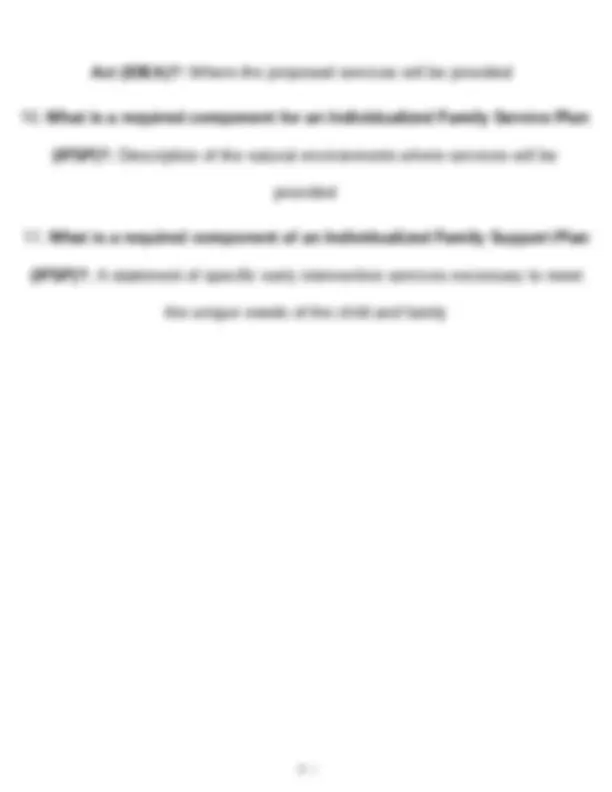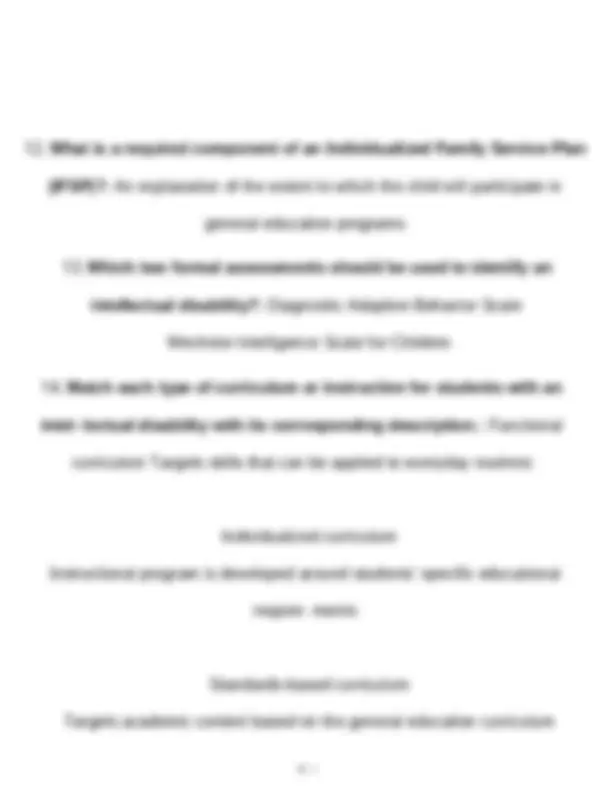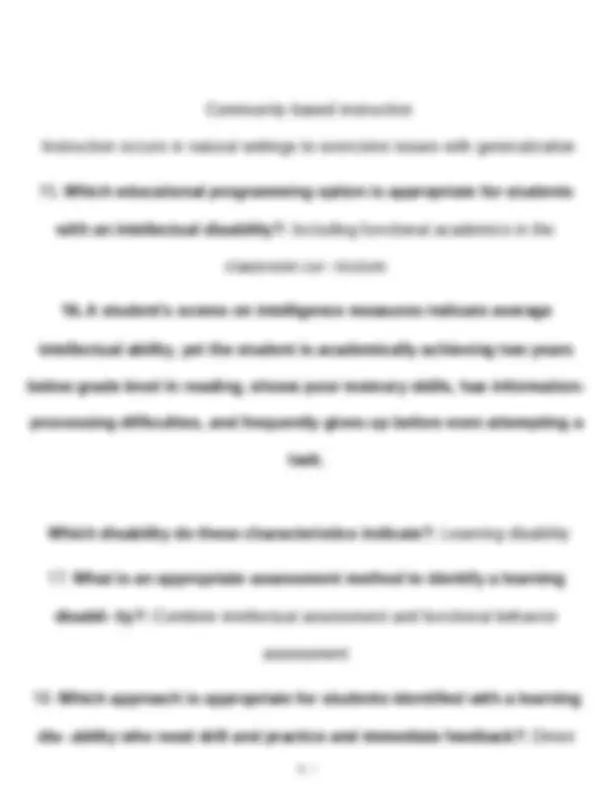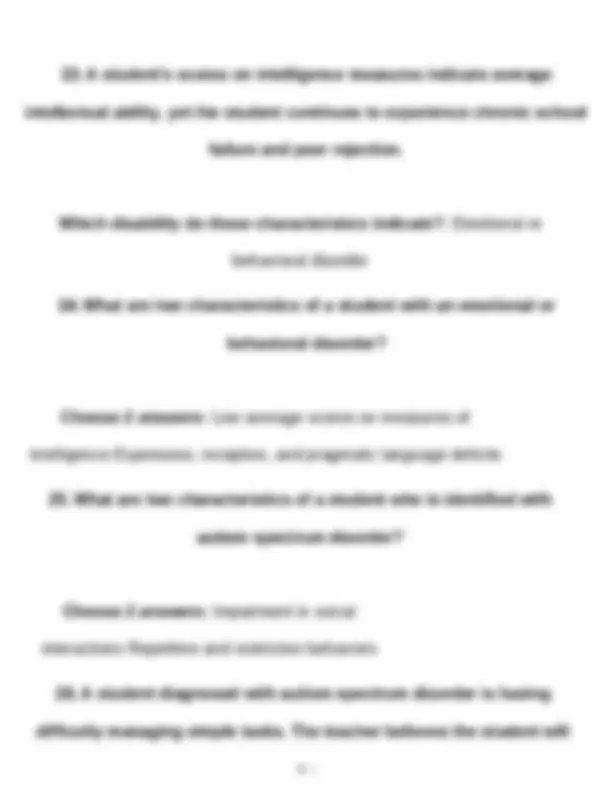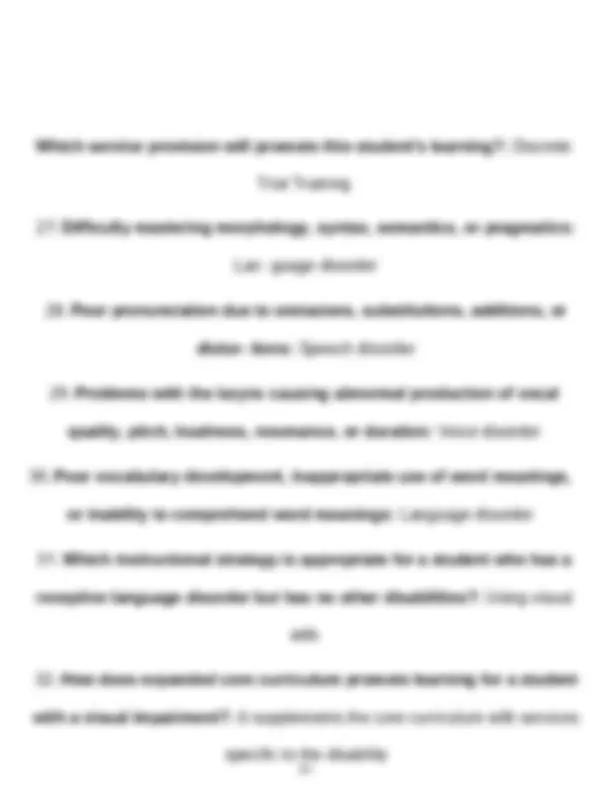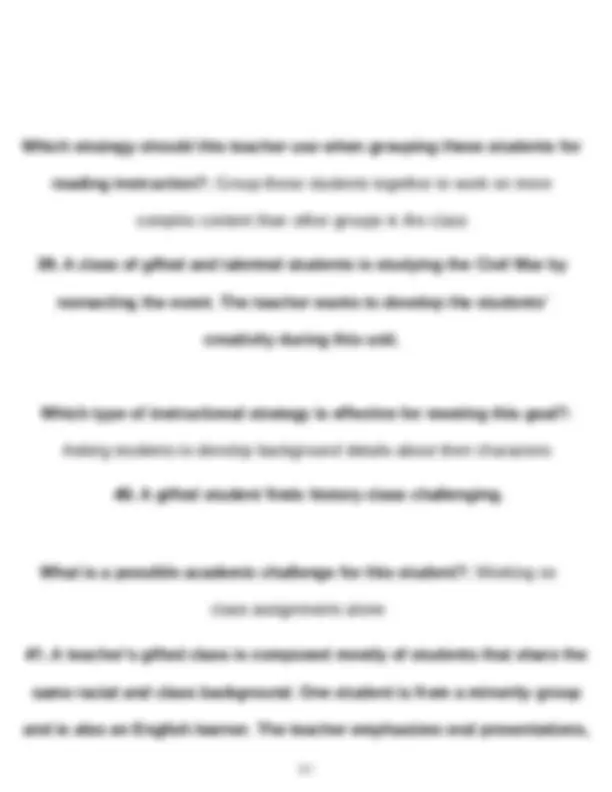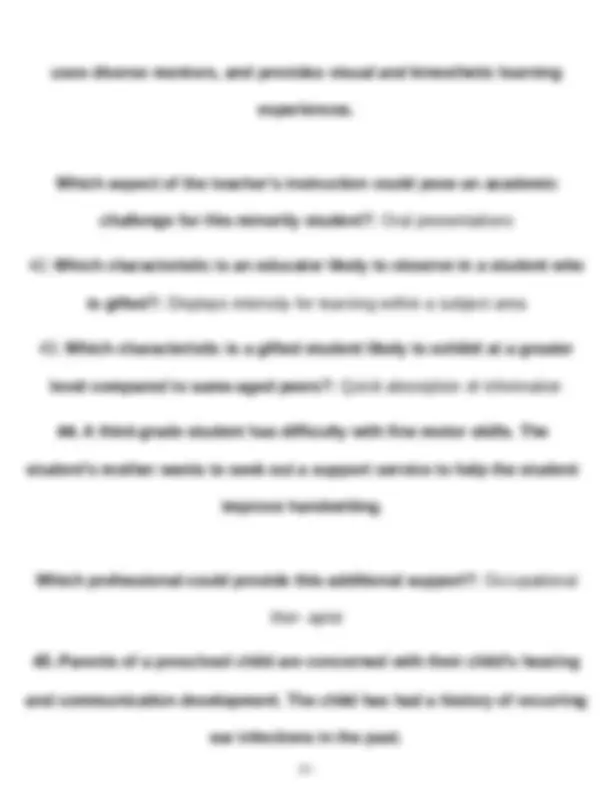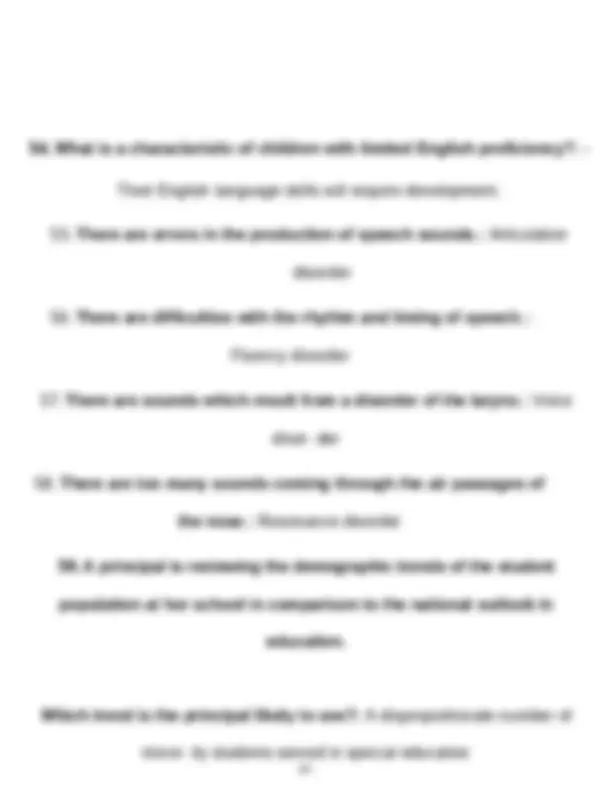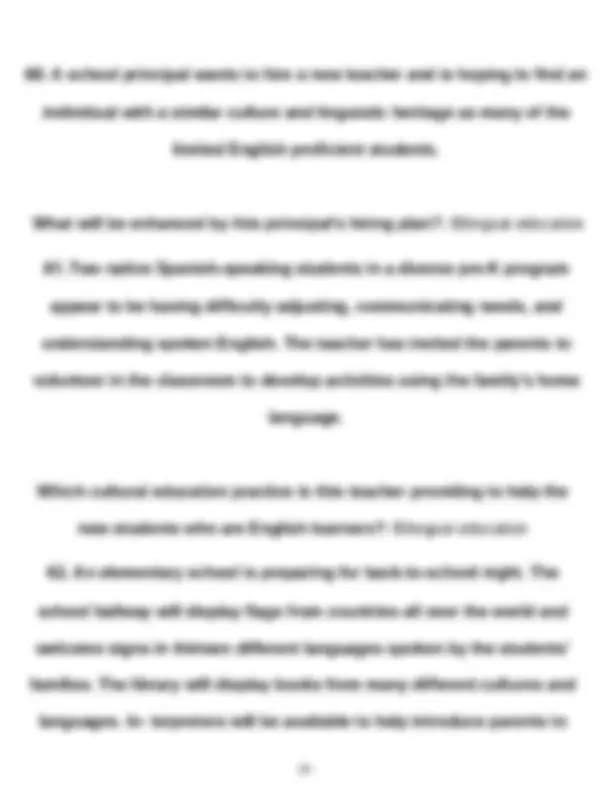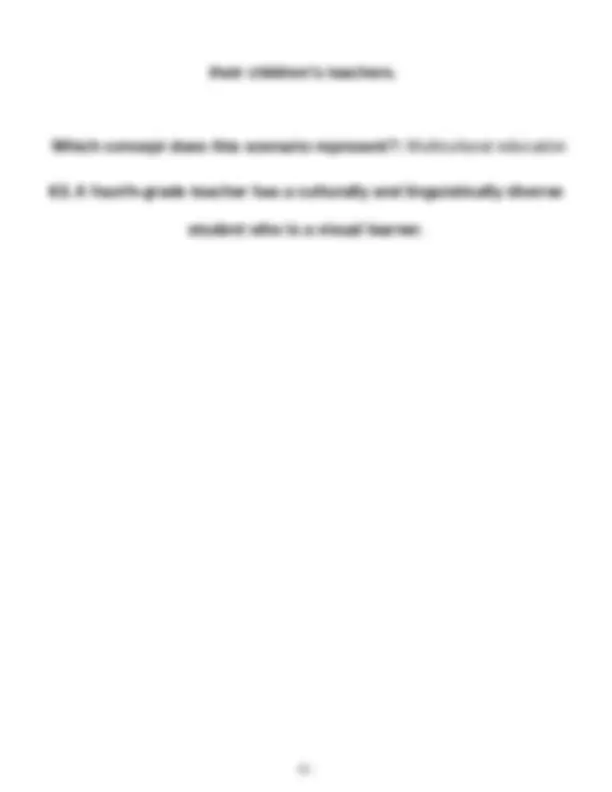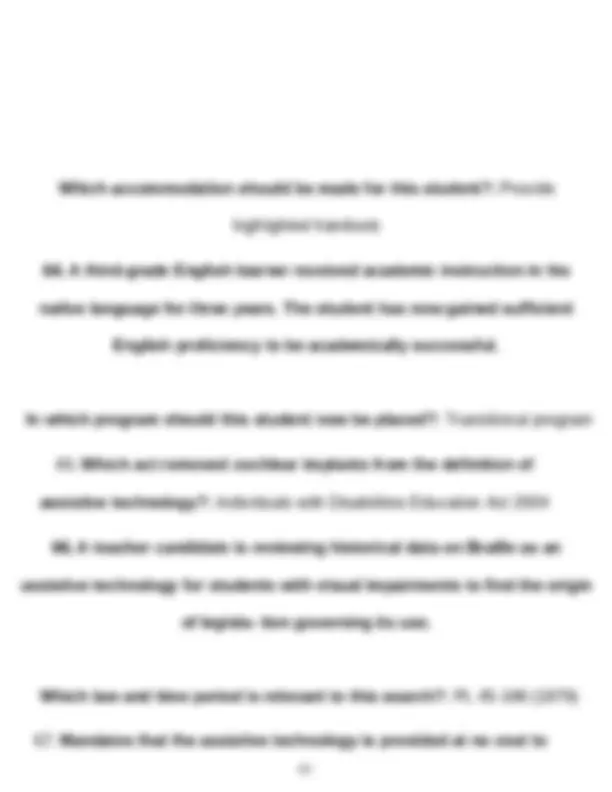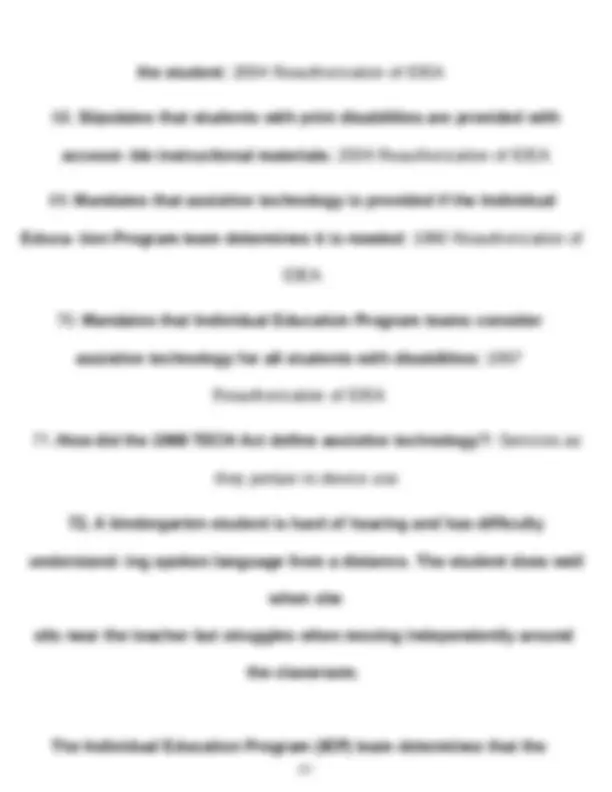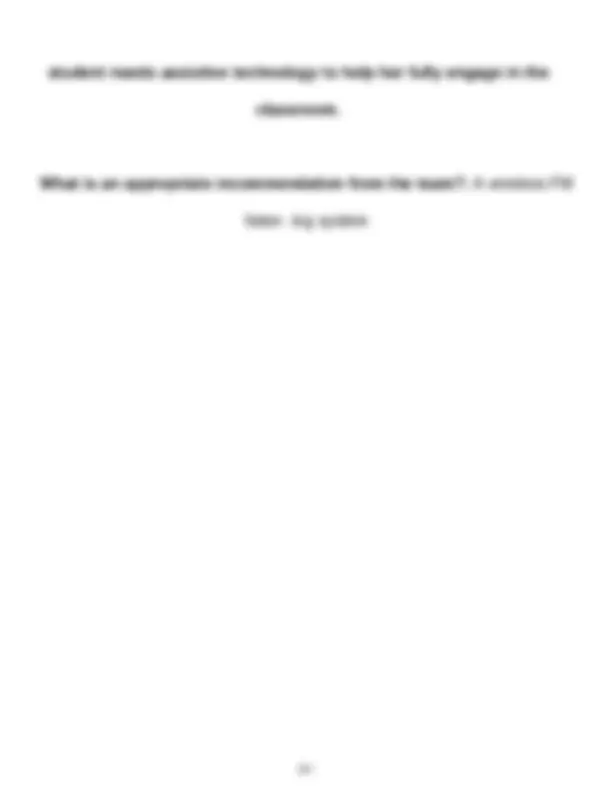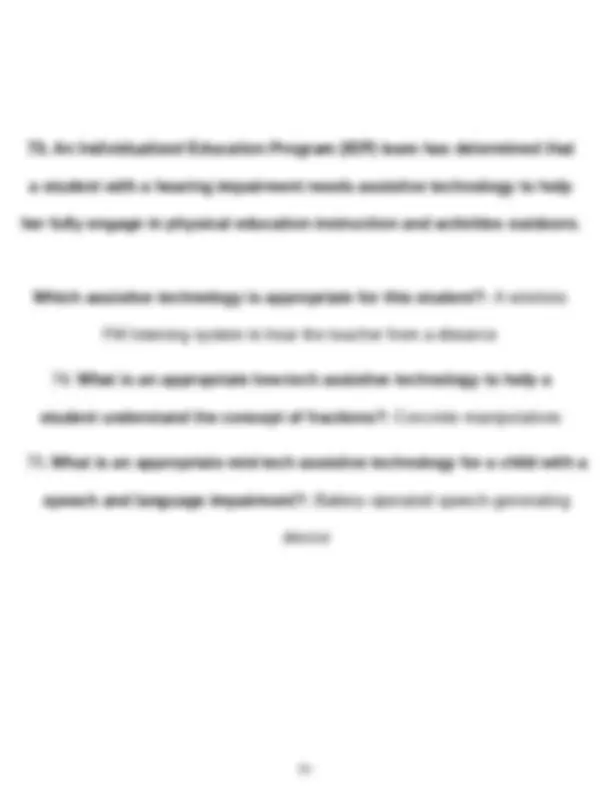Download PRE-ASSESSMENT: FUNDAMENTALS OF DIVERSITY, INCLUSION and more Exams Pharmaceutical Statistics in PDF only on Docsity!
PRE-ASSESSMENT: FUNDAMENTALS OF DIVERSITY, INCLUSION,
AND EXCEPTIONAL LEARNERS WGU QUESTIONS AND CORRECT
ANSWERS(VERIFIED
- What is the least restrictive environment for a second-grade student with minimal behavior challenges who needs assistance with reading fluency?: - Resource room
- What is the least restrictive environment for a student who has multiple disabilities and needs assistance with self-care?: Separate class 3. A student who is an English learner has attention deficit hyperactivity disorder and is falling behind academically. The teacher refers the student for comprehensive assessment to determine specific learning issues so that learning can be best tailored to the needs of the student. Which type of assessment accommodation will allow the student to perform best during the assessment?: Scheduling frequent breaks during the assess- ment
4. A student with a disability struggles to read standard print. Which type of assessment accommodation will best support this student?- : Presentation
- Which instructional service delivery model outside of the regular class- room is considered least restrictive for students with disabilities?: Resource room
- Where do the majority of students with disabilities receive the majority of their educational services?: Regular classrooms 7. How frequently must the Individualized Education Program (IEP) be re- viewed according to the Individuals with Disabilities Education Act (IDEA)?- : Every 12 months
- Which information must be included in an Individual Education Plan (IEP)?: The student's level of participation in the general education curriculum
- What must the Individualized Education Program (IEP) include for all students with disabilities under the Individuals with Disabilities Education
- What is a required component of an Individualized Family Service Plan (IFSP)?: An explanation of the extent to which the child will participate in general education programs
- Which two formal assessments should be used to identify an intellectual disability?: Diagnostic Adaptive Behavior Scale Wechsler Intelligence Scale for Children
- Match each type of curriculum or instruction for students with an intel- lectual disability with its corresponding description.: Functional curriculum Targets skills that can be applied to everyday routines Individualized curriculum Instructional program is developed around students' specific educational require- ments Standards-based curriculum Targets academic content based on the general education curriculum
Community-based instruction Instruction occurs in natural settings to overcome issues with generalization
- Which educational programming option is appropriate for students with an intellectual disability?: Including functional academics in the classroom cur- riculum 16. A student's scores on intelligence measures indicate average intellectual ability, yet the student is academically achieving two years below grade level in reading, shows poor memory skills, has information- processing difficulties, and frequently gives up before even attempting a task. Which disability do these characteristics indicate?: Learning disability
- What is an appropriate assessment method to identify a learning disabil- ity?: Combine intellectual assessment and functional behavior assessment
- Which approach is appropriate for students identified with a learning dis- ability who need drill and practice and immediate feedback?: Direct
- Which assessment method is often used to help diagnose attention deficit hyperactivity disorder in conjunction with a medical evaluation?: The teachers and parents complete behavioral rating scales.
- Which instructional strategy helps students diagnosed with attention deficit hyperactivity disorder identify and control their own behaviors?: - Self-regulation 22. Despite the school year being more than half over, a kindergarten teacher has observed that a student continues to play alone during free time and does not have any friends beside the adult staff. The student often becomes frustrated and acts out aggressively. Children similar to this student have difficulty establishing and maintaining relationships, display inappropriate interpersonal skills, and have a likelihood for displaying aggressive behav- ior. Which disability is represented by this student's characteristics?: Emotional or behavioral disorder
23. A student's scores on intelligence measures indicate average intellectual ability, yet the student continues to experience chronic school failure and peer rejection. Which disability do these characteristics indicate?: Emotional or behavioral disorder 24. What are two characteristics of a student with an emotional or behavioral disorder? Choose 2 answers: Low average scores on measures of intelligence Expressive, receptive, and pragmatic language deficits 25. What are two characteristics of a student who is identified with autism spectrum disorder? Choose 2 answers: Impairment in social interactions Repetitive and restrictive behaviors 26. A student diagnosed with autism spectrum disorder is having difficulty managing simple tasks. The teacher believes the student will
Which service provision will promote this student's learning?: Discrete Trial Training
- Difficulty mastering morphology, syntax, semantics, or pragmatics: Lan- guage disorder
- Poor pronunciation due to omissions, substitutions, additions, or distor- tions: Speech disorder
- Problems with the larynx causing abnormal production of vocal quality, pitch, loudness, resonance, or duration: Voice disorder
- Poor vocabulary development, inappropriate use of word meanings, or inability to comprehend word meanings: Language disorder
- Which instructional strategy is appropriate for a student who has a receptive language disorder but has no other disabilities?: Using visual aids
- How does expanded core curriculum promote learning for a student with a visual impairment?: It supplements the core curriculum with services specific to the disability
33. A student with a hearing impairment is using a combination of American Sign Language, fingerspelling, and speechreading. What is an appropriate service provision to promote this student's learning?- : Total communication 34. A student is blind and is sometimes included in the general education classroom with peers. What is an appropriate service provision that will promote this student's learning?: Speech-to-text
- Which assistive technology will improve the ability of a student with a hearing impairment to participate in classroom discussions with other students?: FM system
- Which assessment provides a formal and comprehensive measure of giftedness?: Wechsler Intelligence Scale for Children
- What are jot-downs and checklists?: Informal measures for assessing gift- edness
Which strategy should this teacher use when grouping these students for reading instruction?: Group these students together to work on more complex content than other groups in the class
39. A class of gifted and talented students is studying the Civil War by reenacting the event. The teacher wants to develop the students' creativity during this unit. Which type of instructional strategy is effective for meeting this goal?: Asking students to develop background details about their characters 40. A gifted student finds history class challenging. What is a possible academic challenge for this student?: Working on class assignments alone 41. A teacher's gifted class is composed mostly of students that share the same racial and class background. One student is from a minority group and is also an English learner. The teacher emphasizes oral presentations,
uses diverse mentors, and provides visual and kinesthetic learning experiences. Which aspect of the teacher's instruction could pose an academic challenge for this minority student?: Oral presentations
- Which characteristic is an educator likely to observe in a student who is gifted?: Displays intensity for learning within a subject area
- Which characteristic is a gifted student likely to exhibit at a greater level compared to same-aged peers?: Quick absorption of information 44. A third-grade student has difficulty with fine motor skills. The student's mother wants to seek out a support service to help the student improve handwriting. Which professional could provide this additional support?: Occupational ther- apist 45. Parents of a preschool child are concerned with their child's hearing and communication development. The child has had a history of recurring ear infections in the past.
- A student with which disability will benefit from vocational training, func- tional curriculum, community based instruction, and inclusion?: Intellectual disability 47. An Individualized Education Program (IEP) team identified the following service provisions:
- Social Skills Training
- Interpersonal Problem Solving
- Conflict Resolution A student with which disability will benefit from these services?: Emotional or behavioral disorder
- Which statement defines the contemporary role of caregivers of children with disabilities?: Participates as a team member in decision making
- How has the role of professionals evolved in the caregivers- professionals relationship?: From responding to family needs in a general way
to individualizing for the family
- How does the cultural and linguistic diversity of families affect their relationship with educators?: Families' limited English proficiency could pose a challenge to clear communication with teachers. 51. Which positive approach should a teacher use when speaking with a diverse family about group home options for their child with a disability?- : Demonstrate culturally sensitive behavior during the discussions 52. A parent of a child who is diagnosed with autism spectrum disorder is experiencing guilt as expressed by the parent's statements that include, "If only I had not vaccinated him, or maybe if I had breastfed him longer." Which phase is the parent experiencing as a result of the diagnosis?: Sec- ondary phase 53. A student's preschool teacher and team are reviewing test results that show the student has a developmental delay. The parents believe the team neither understands nor likes their son, and they refuse to agree to the recommended services.
54. What is a characteristic of children with limited English proficiency?: - Their English language skills will require development.
- There are errors in the production of speech sounds.: Articulation disorder
- There are difficulties with the rhythm and timing of speech.: Fluency disorder
- There are sounds which result from a disorder of the larynx.: Voice disor- der
- There are too many sounds coming through the air passages of the nose.: Resonance disorder 59. A principal is reviewing the demographic trends of the student population at her school in comparison to the national outlook in education. Which trend is the principal likely to see?: A disproportionate number of minor- ity students served in special education
60. A school principal wants to hire a new teacher and is hoping to find an individual with a similar culture and linguistic heritage as many of the limited English proficient students. What will be enhanced by this principal's hiring plan?: Bilingual education 61. Two native Spanish-speaking students in a diverse pre-K program appear to be having difficulty adjusting, communicating needs, and understanding spoken English. The teacher has invited the parents to volunteer in the classroom to develop activities using the family's home language. Which cultural education practice is this teacher providing to help the new students who are English learners?: Bilingual education 62. An elementary school is preparing for back-to-school night. The school hallway will display flags from countries all over the world and welcome signs in thirteen different languages spoken by the students' families. The library will display books from many different cultures and languages. In- terpreters will be available to help introduce parents to

